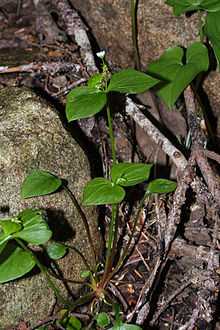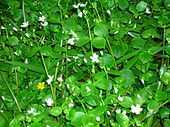Claytonia sibirica

| Claytonia sibirica | |
|---|---|
 | |
| Scientific classification | |
| Kingdom: | Plantae |
| (unranked): | Angiosperms |
| (unranked): | Eudicots |
| (unranked): | Core eudicots |
| Order: | Caryophyllales |
| Family: | Montiaceae |
| Genus: | Claytonia |
| Species: | C. sibirica |
| Binomial name | |
| Claytonia sibirica L. | |
Claytonia sibirica (Siberian Spring Beauty, Siberian Miner's Lettuce, Candy Flower or Pink Purslane) is a flowering plant in the family Montiaceae, native to Siberia and western North America. A synonym is Montia sibirica. The plant was introduced into the United Kingdom by the 18th century where it has become very widespread.[1]
Habitat and description
It is found in moist woods. It is short-lived perennial or annual with hermaphroditic flowers which are protandrous and self-fertile. The numerous fleshy stems form a rosette and the leaves are lanceolate. The flowers are 8-20 mm diameter, with five white, candy-striped, or pink petals, flowering is between February and August.
The Stewarton flower

An example of the variation found in Claytonia sibirica is the subspecies known as the Stewarton Flower, so named due to its local abundance in that part of North Ayrshire, Scotland and recorded as such by the Kilmarnock Glenfield Ramblers.[1]
In 1915 it was stated to have been in the Stewarton area for over 60 years and was abundant on the Corsehill Burn.[1] As the plant is very adept at reproducing by asexual plantlets, this has maintained the white varieties gene pool around Stewarton. The pink variety has not been able to predominate here, and only occurs occasionally, unlike most other localities in Scotland.
References
External links
| Wikimedia Commons has media related to Claytonia sibirica. |
- Flora of North America: Claytonia sibirica
- Burke Museum in WA State: Claytonia sibirica
- Jepson Manual Treatment: Claytonia sibirica
- Cal photos: Claytonia sibirica